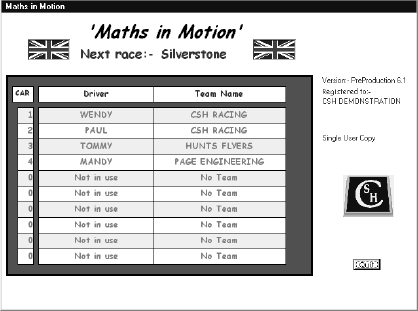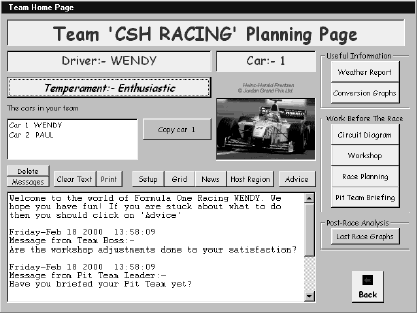
| 3 | contents | Newsletter: Summer 2000 |
Brian Richardson
CSH
Looking back to the early 1980's, being involved in the production of educational software was both exciting and innovative and, I have to say, it was probably a bit hit and miss! No one really knew what we should be doing with computers in our schools, let alone what software we should be producing, yet everybody seemed to have a model theory of their own. Teachers who were lucky enough to have computers in their classrooms experimented with all kinds of software and generally they were exciting times.

In 1984, we at Cambridgeshire Software House published a program entitled 'Cars-Maths in Motion' and launched it at that year's M.A.P.E. Conference. Since starting our fledgling company some four years earlier, we had produced about twenty programs and were becoming well known for our simulations (Expedition to Saqqara, Adventure Island, Mary Rose etc.). At the time, some teachers were a little wary of using this type of software, mostly through 'fear of the unknown', but 'Cars', as it soon became known, was to change everything for them. Here was a cross curricular simulation, based in the exciting world of Grand Prix racing, that heavily featured practical mathematics and that the children actually enjoyed using! Apart from helping them to learn some basic skills, the software showed children that mathematics could be fun and 17 years later, the rest, as they say, is history! The program became the most popular cross curricular simulation ever and many an in-service training course from Winchester to Aberdeen finished with teachers screaming at a 14" monitor in the hope that it would make their car go faster!

The software has undergone little change since its original publication and has, until now, only been reprogrammed by us to cater for new operating systems. However, that has now all changed. With 'Maths Year 2000' in mind, we started over 2 years ago to completely redesign the program. We wanted to put in some of your suggestions and make the software even more relevant to the teaching methods of today. I am very pleased to say that we showed the new version at the recent NAACE Conference in Blackpool. I make no apology for the fact that children will still need to use protractors, will still need to use scale, will still need to calculate percentages and will still have the opportunity to experiment with the mathematical model. Children will be able to ask 'what happens if…?', 'what chance shall we take…?' etc. when using this software and they will experience the use of ratios, measuring angles, strategy, speed, time, bar, line and conversion graphs whilst attempting to set up a car to win a race. As an aside, we have a very useful support document on our web site (http://ourworld.compuserve.com/homepages/cshsoft) which details the parts of the Numeracy Document where the program covers various aspects of it for Years 5, 6, 7 and 8. We have also listed the parts of the Scottish 5-14 Guidelines that are covered by the program.

The launch went very well and one of the new features that captured the imagination of most delegates is the ability to import and export cars from and to other users of the software. This will mean that schools could send cars to each other and race against each other.
The new program is called simply 'Maths in Motion' and is available on CD ROM. It is compatible with Windows '95 and '98 and costs £49.95 + carriage and VAT, direct from us at the address below. I know from correspondence that many teachers still use what is now the old software to help deliver the various curricula requirements in their schools. I am therefore pleased to tell you that if a school returns to us the original package, track plans and discs, then that school can purchase the new program for only £30.00 + carriage and VAT. This offer will be open for a very limited period only.
CSH can be contacted at:
Cambridgeshire Software House
P.O. Box 163
Huntingdon
Cambridgeshire
PE28 3UR
Tel: 01487 741223
Fax: 01487 741213